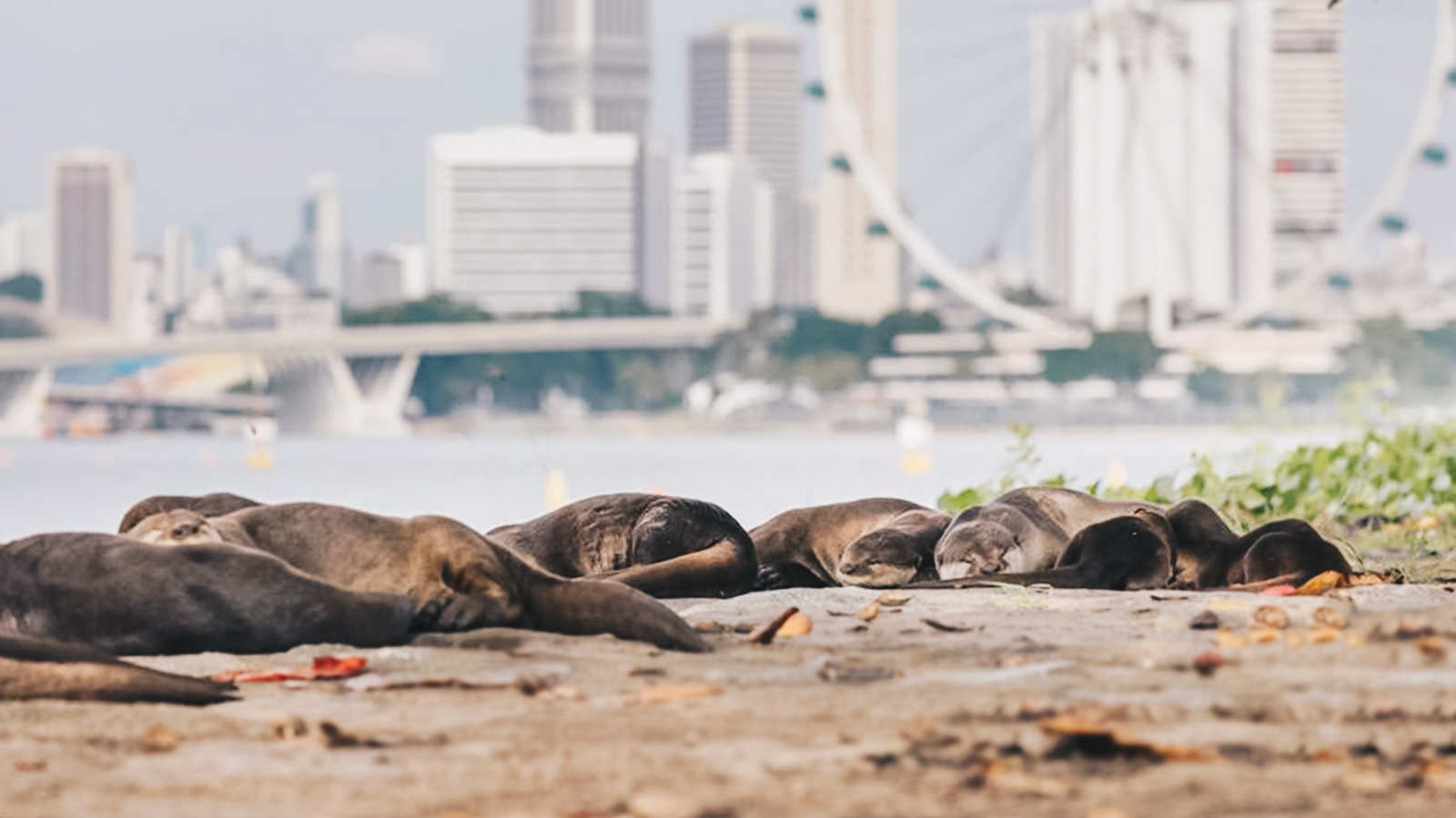Imagine seeing a wild boar in your neighbourhood. How would you react?
Odds are, you would freeze like a deer in the headlights and start panicking for your safety.
If this is the fear you feel when you encounter wildlife in our urban quarters, wildlife expert Subaraj Rajathurai will have you know that these feelings are unfounded.
The 54-year-old, a wildlife tour guide licensed by the Singapore Tourism Board and whose interest in wildlife has spanned 37 years, told The Pride: “I’ve never been attacked by anything. Not even snakes, which people say will jump out from the bushes and chase you. I’ve been waiting and I still can’t find a snake that will chase me. It’s always me chasing them.”
Not to attack them, of course, but to photograph them.
But what about negative incidents involving local wildlife?
Otters were first regarded as a nuisance three years ago because they were seen feeding on prized fishes in Sentosa, much to the dismay of residents there. Last year also saw two instances of members of the public getting injured by local wildlife. A wild boar attacked a man in Hillview Avenue, while a five-year-old girl was bitten by an otter.

In many of these encounters, it may not be fair to pin the blame solely on the animals.
Speaking to The Pride, deputy chief executive of Animal Concerns Research and Education Society (ACRES), Anbarasi Boopal explained: “It clearly shows that we are lacking education and awareness. The otter was a young individual as part of a social group of animals, who was approached too closely for comfort. In defence, the otter nipped (the girl) and fled.
“Most wild animals will keep their distance from humans unless they have been conditioned by human food provision or they feel threatened or cornered.”
Other stories you might like


The fear of the unknown
On the otters that fed on expensive fishes in Sentosa, Boopal said: “We have diverse wild animals in our garden city and otters obviously cannot differentiate between expensive or pet fish to prey on. When we live so closely beside wildlife habitats, it is important to learn about co-existence and how conflicts can be addressed without taking a reactive approach of simply removing unwanted animals.
Otters nom noming in Singapore canal 🇸🇬 (btw Twitter needs an otter emoji that is Singapore specific) pic.twitter.com/AyrIfIi3CR
— Mothership.sg (@MothershipSG) 5 February 2018
“People may react strongly because we are not aware, and fear is the first reaction when you are not aware of what is happening.”
While Subaraj agreed that the public’s reactions are “natural”, he felt that the problem is made worse by a culture of fearmongering.
“Today, when you communicate via word-of-mouth, it may not be based on facts. It’s just people making up stories. But, there are people out there studying wildlife that can give you intelligent answers. Whether it comes from the universities or nature groups or overseas, intellectual answers are the ones you want to seek; not rumours.”
To those who oppose the presence of wildlife because of safety concerns, he would ask them this: “How is it that there are so many attacks by wild boars on the mainland and yet Pulau Ubin, which has had a large population of wild boars for the longest time, has no major incidents involving people?”
Related article: He leaves behind a life of crime and vice to help others
In Subaraj’s view, the solution is for people to have “a better understanding of wildlife through education” so that we can “slowly learn to co-exist with our local wildlife”.
Of the calls ACRES receives for asking for assistance, Boopal observed that there are people who call because of “monitor lizard sightings in drains, noisy animals outside their house, or snakes living outside their condominiums”.
Through these conversations, she said that ACRES has noticed “that majority of the callers may not be aware of native wildlife and wildlife etiquette”.
Education is key
Both Subaraj and Boopal agree that education is key to changing the public’s at times antagonistic behaviour towards local wildlife and to promote co-existence and tolerance.
By understanding the nature and behaviour of these animals, and how our actions have conditioned them, we’re less prone to having knee-jerk reactions everytime something bad happens.

Pointing to the macaque disturbances that came into prominence since 2013, Subaraj said: “For the longest time, people have been complaining about monkeys, but monkeys were never like this. I knew some of the troops, like the one in Bukit Timah, before they became notorious. I knew them since 1981. In those days, when the monkeys see you, they run up the tree and they look at you.”
However, Subaraj observed, as people started feeding them, we inadvertently changed their behaviour. “They no longer fear us and they associate plastic bags with food for them,” he said.
Boopal echoed his concerns, saying: “Birds, macaques and wild pigs are fed by humans who think they do not have enough food, and these animals end up being habituated to humans. That can result in serious conflict situations and one example is the Segar Road monkey situation.”
Related article: Would you forgive your father if he’d walked out on your family?
Learning to be mindful of our interactions with local wildlife is essential as experts foresee more run-ins with wildlife due to urbanisation.
As Boopal explained: “With increasing development, their habitats will get more fragmented. Animals will be forced to explore new green pockets through man-made corridors such as park connectors, or risk crossing expressways, bridges or residential areas. This is why education on co-existence is vital, because wildlife is no longer restricted to reserves.”
Culling is not the solution
On the surface, culling may seem like a viable option, but Boopal sees ecological and human factors as more critical in solving the problem.
She said: “If humans provide food directly (by feeding) or indirectly (improper food waste or trash management), the wildlife population will increase proportionately.

“Culling may seem like a quick-fix but many cases have proven that culling is not an effective solution, if the root cause of the issue is not resolved.”
There also needs to be a more scientific approach to culling, as Subaraj explained: “Without knowing the actual numbers, how will we know if there is a need to cull or how much we need to cull? We need to do proper studies to figure out numbers and distribution, otherwise we’ll be impacting the biodiversity of the ecosystem and the food chain.”
Both experts viewed culling as a last resort, and cited other more humane and scientific methods of conserving and managing the wildlife population.
ACRES works closely with other agencies to rehabilitate wild animals in distress, and also conducts educational talks to share about their efforts. A Nature Conservation Master Plan (NCMP) has also been implemented recently, as a five-year biodiversity conservation plan put together by NParks, in consultation with the universities and nature groups.
“At the end of the day, nothing works unless everybody works together. So the government, academia and the public have to work together,” Subaraj said.
More Singaporeans in support of wildlife
Fortunately, there is support among the public for conserving our wildlife.
A 2015 ACRES survey found that less than 15 per cent of the 600 participants polled were in support of culling, while about half of the respondents were undecided. Conversely, a significant proportion – 31 to 44 per cent – felt that culling should not be allowed.

The results were encouraging, as Boopal felt the large number of undecided participants indicated “a strong sense of compassion” and was a “huge opportunity” for ACRES to widen its public education efforts.
She said: “ACRES is working towards a compassionate society which respects all animals as sentient beings. One does not have to love them, but have to learn to co-exist with them.
“Respecting their behaviour and giving them that space will go a long way in reducing the conflict scenarios.”
Related article: Foreign worker donates to rescue group, begs them to feed stray dogs on his behalf
What to do when you encounter a wild animal?
1. Appreciate them from a distance
2. Slowly back away if they’re coming too close
3. Don’t provoke them by staring or showing your teeth
4. Don’t treat wild animals like pets by touching, restraining or feeding them
5. If the animal is injured, call ACRES at their 24-hour wildlife rescue hotline at 97837782 for assessment or advice
6. Never attempt to approach, touch or move an injured wild animal as it may feel threatened and turn aggressive in a bid to protect itself
For more information on Singapore’s native wildlife and what to do if you encounter wild animals, please visit ACRES.
